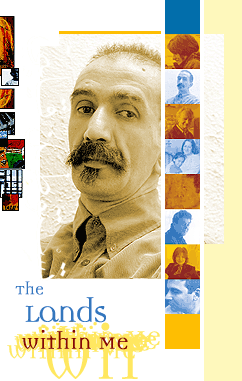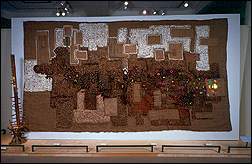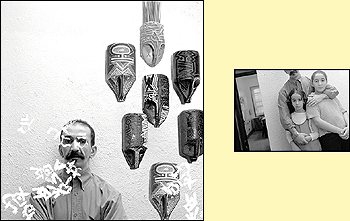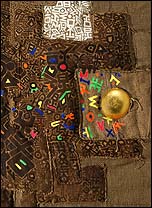
|
 La vache des orphelins, 2000 (The Orphans' Cow) Installation: pigments on woven and stuffed jute canvas, wood Lent by the artist (Photo: Harry Foster © Canadian Museum of Civilization Corporation) " Once upon a time, in a village lived a man who had a wife and two children. The mother owned a cow. But one day she fell ill. When she felt herself near death, she called her husband and said to him, 'Promise me that you will not sell the cow, that you will keep it always for the little orphans ... ' With this extract from the tale The Orphans' Cow, I want the orphans to represent the people, left to their own devices, and the cow to represent the country. In a sense, the theme is a pretext for artistic and technical confrontations. [...]
In terms of form, my aesthetic and cultural inspirations and peregrinations lead me -
or rather, essentially, bring me back - to primitive art, to the Kabyle homes of Algeria,
decorated with a profound emotional mastery by women. To African masks, to those Berber
carpets and signs [...], as well as to the M'zab and its admirable architecture. " Excerpts from the artist's statement A native of Béjaïa, Algeria, Ali Kichou was born in 1959. He was admitted to the National School of Fine Arts in Algiers in 1978, then to the Academy of Fine Arts in Rome in 1983. He later became a restorer of art in Italy, where he lived for a period of 14 years. The discovery he made, at the beginning of the 1980s, of the little-known art treasures his country harboured-the Tassili frescoes, Berber handicrafts, homes designed by Kabyle women-encouraged him to radically break away from traditional Western painting. He researched new materials and replaced the canvas as the support of a work: My work, my artistic approach, is a constant reappraisal of accepted techniques, which are conventional and therefore of a historical nature.  Ali Kichou with his daughters Tinhinane Yasmina Kichou and Assa Djazia Kichou, Montreal, Quebec, 1999 Camille Zakharia Iris digital prints Collection of the Canadian Museum of Civilization From that time on, Ali Kichou used burlap and glue in order to give relief to his works, and revived the "sign," an ancestral mode of expression. He joined with the group Movimento Trattista ("Strokes in Movement") and created installations that were more aesthetic than thematic, to which he soon added the dimension of sound. There is a parallel between his work and theatre, with its costumes and props and the richness of its artistic setting. He thus tries to rejoin with the universal by drawing from the cultural sources of different peoples. When questioned on his identity, he responds, Honestly, I don't feel Arab, I feel Algerian. When I dream, I don't dream in Arabic . . . , I dream in Berber, I cry in Berber. But I feel concerned because I am part of the Arab world . . . and the Arab world is rejected.  La vache des orphelins (detail), 2000 (The Orphans' Cow) Installation: pigments on woven and stuffed jute canvas, wood Lent by the artist (Photo: Harry Foster © Canadian Museum of Civilization Corporation) A great traveller, he has been to Berlin, Stockholm, Budapest, everywhere that his works have been exhibited. Struck by the population density in Europe, preoccupied by the future of his children and wishing to improve living conditions for his family, he decided with his wife, the artist Hadjira Preure, to immigrate to Quebec in 1995. Ali Kichou has participated in nearly 80 solo and collective exhibitions in Europe, including the Scandinavian countries, as well as in Algeria and Canada. Several Italian, Hungarian and Algerian museums have acquired one or more of his works. |